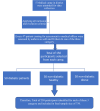Unraveling the enigma of sarcopenia and sarcopenic obesity in Indian adults with type 2 diabetes - a comparative cross-sectional study
- PMID: 38880930
- PMCID: PMC11181647
- DOI: 10.1186/s40842-024-00179-4
Unraveling the enigma of sarcopenia and sarcopenic obesity in Indian adults with type 2 diabetes - a comparative cross-sectional study
Abstract
Background: Sarcopenia and sarcopenic obesity are growing concerns associated with increasing diabetes incidence, but data from Indian diabetic cohorts are limited. This study examined the prevalence and clinical factors associated with sarcopenia and sarcopenic obesity.
Methods: In this cross-sectional study, 750 participants aged 35-70 years were recruited by systematic stratification and a fixed quota sampling technique from medical camps and categorized into diabetic (n = 250), nondiabetic (n = 250), and obese nondiabetic (n = 250) groups. The assessments included questionnaires, muscle mass estimation by bioimpedance analysis, and blood tests. Sarcopenia was defined using the Asian Working Group consensus, and sarcopenic obesity was defined as sarcopenia with a BMI ≥ 25 kg/m2. Logistic regression was used to analyze risk factors.
Results: Sarcopenia affected 60% of diabetic patients, 28% of nondiabetic patients, and 38% of nonobese nondiabetic patients (p < 0.001). The prevalence of sarcopenic obesity was 40%, 11%, and 30%, respectively (p < 0.001). Diabetes was associated with 2.3-fold greater odds (95% CI 1.1-4.7) of sarcopenia and 2.4-fold greater odds (1.1-5.0) of sarcopenic obesity after adjustment. A duration greater than 10 years, uncontrolled diabetes, age greater than 65 years, low physical activity, hypertension, and dyslipidemia also independently increased the odds.
Conclusion: Indian adults with type 2 diabetes have a high burden of sarcopenia and sarcopenic obesity. Early optimization of diabetes care and lifestyle changes are vital for preserving muscle health.
Keywords: Complication; Diabetes; India; Prevalence; Sarcopenia.
© 2024. The Author(s).
Conflict of interest statement
The authors declare that they have no competing interests.
Similar articles
-
Association of Obesity, Sarcopenia, and Sarcopenic Obesity With Hypertension in Adults: A Cross-Sectional Study From Ravansar, Iran During 2014-2017.Front Public Health. 2022 Feb 2;9:705055. doi: 10.3389/fpubh.2021.705055. eCollection 2021. Front Public Health. 2022. PMID: 35186858 Free PMC article.
-
Type 2 diabetes: is obesity for diabetic retinopathy good or bad? A cross-sectional study.Nutr Metab (Lond). 2024 Aug 19;21(1):68. doi: 10.1186/s12986-024-00842-8. Nutr Metab (Lond). 2024. PMID: 39160558 Free PMC article.
-
Understanding factors associated with sarcopenic obesity in older African women from a low-income setting: a cross-sectional analysis.BMC Geriatr. 2021 Apr 14;21(1):247. doi: 10.1186/s12877-021-02132-x. BMC Geriatr. 2021. PMID: 33853546 Free PMC article.
-
Critical appraisal of definitions and diagnostic criteria for sarcopenic obesity based on a systematic review.Clin Nutr. 2020 Aug;39(8):2368-2388. doi: 10.1016/j.clnu.2019.11.024. Epub 2019 Nov 27. Clin Nutr. 2020. PMID: 31813698
-
Sarcopenic obesity as a determinant of cardiovascular disease risk in older people: a systematic review.Postgrad Med. 2021 Nov;133(8):831-842. doi: 10.1080/00325481.2021.1942934. Epub 2021 Jul 12. Postgrad Med. 2021. PMID: 34126036
Cited by
-
Sarcopenia in type 2 Diabetes mellitus among Asian populations: prevalence and risk factors based on AWGS- 2019: a systematic review and meta-analysis.BMC Endocr Disord. 2025 Apr 17;25(1):101. doi: 10.1186/s12902-025-01935-y. BMC Endocr Disord. 2025. PMID: 40247215 Free PMC article.
-
An Indian Consensus on Sarcopenia: Epidemiology, Etiology, Clinical Impact, Screening, and Therapeutic Approaches.Int J Gen Med. 2025 Mar 26;18:1731-1745. doi: 10.2147/IJGM.S510412. eCollection 2025. Int J Gen Med. 2025. PMID: 40165836 Free PMC article.
References
LinkOut - more resources
Full Text Sources
Miscellaneous


